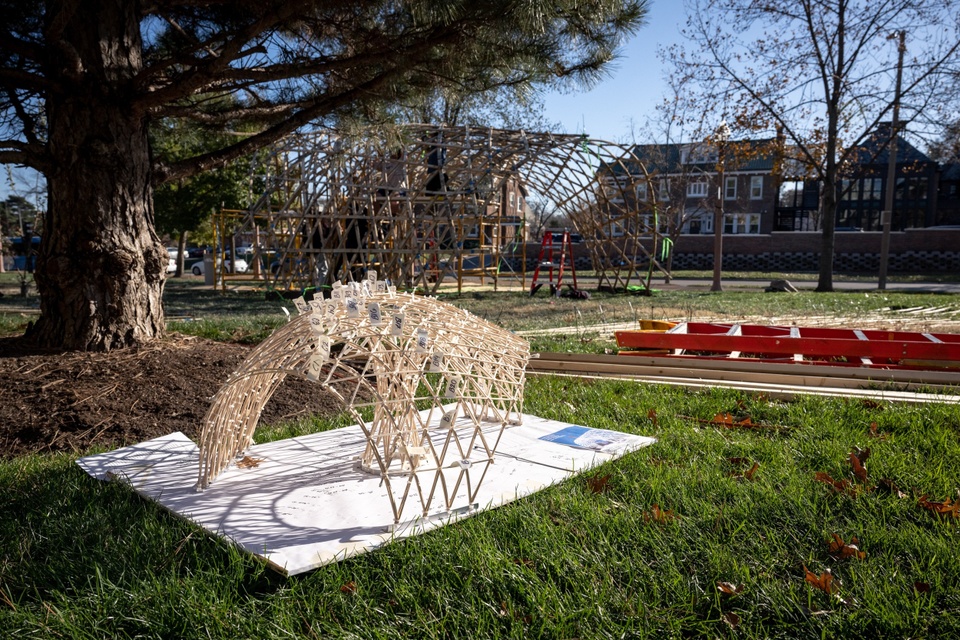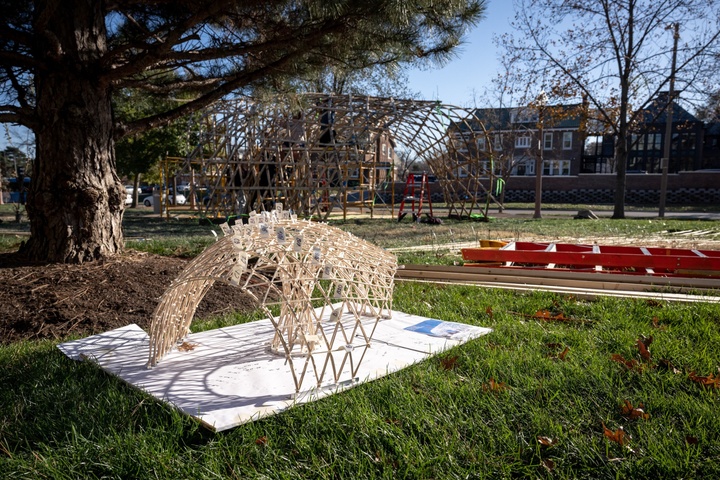Weaving Together the Vision for Peace Park
2022-12-29 • Sam Fox School

Sam Fox School students build the bamboo pavilion for Peace Park in November 2022. Photo: Carol Green / Washington University.
For five days this November, students, staff, faculty and community members gathered on the lawn south of Steinberg Hall, taking shifts to build a 24-by-32-foot shell of intertwining bamboo strips. Their end goal was the construction of the Gateway Pavilion, a structure that will be a signature feature of the forthcoming Peace Park—a community-driven and community-owned park.
Sam Fox School Assistant Architecture Professor Wyly Brown is the instructor for the fall 2022 course Materials of Memory: Designing a Pavilion for Peace Park, in which students have engaged with Peace Park project partners and College Hill residents to complete the design and build of the pavilion.
“These students have been able to work with a real client, a community—to develop designs, receive feedback, and focus on things like site issues, safety concerns, and the needs of the people. It’s incredibly valuable,” Brown explained. “As well, having the opportunity to build as an architecture student is unusual, but it’s very important.”
Bamboo is not a standard construction material in the St. Louis area, but for this project, Brown said, it was not only practical and sustainable but also meaningful. “It doesn’t require as much skill as other materials. You also use smaller fibers to weave the shell, not long beams; there’s a certain feeling of a literal and metaphorical “grassroots” project, individual entities being woven together.”
In the same way, the project brings the WashU community together with community members and advocates of College Hill, a historic St. Louis neighborhood.
Reducing Health Inequity
The idea for the park emerged from the sobering “For the Sake of All” report, released in May 2015 by Brown School initiative Health Equity Works (HEW). This impactful public health research found that the life expectancy in College Hill, a predominately Black community, was 68 years, significantly shorter than other areas in the county that were just a few miles away.
With facilitation from Health Equity Works, the residents began thinking through ways to reduce the health inequities that plagued their community. They developed a plan to restore a community asset, Peace Park, on what were then vacant lots that held historical significance to the neighborhood.
From there, the Sam Fox School’s Office for Socially Engaged Practice—in partnership with civic and community leaders, including project lead Green City Coalition, a division of the City of St. Louis Economic Development Agency (SLDC) — became engaged as the conduit to facilitate WashU faculty expertise in the park’s implementation.
In the past several years, faculty across WashU have provided critical resources and skills toward this initiative, including Sam Fox School’s Matthew Bernstine (Urban Design), who led a seven-week Community Design Sprints course in spring 2021 focused on the project; Wyly Brown (Architecture); Irene Compadre (Landscape Architecture; BA08, MLA12), whose firm Arbolope Studio has led the landscape design; and Penina Acayo Laker (Communication Design).
Further engagement has taken place across the university, including Beth Biro, Solny Adalsteinsson (Tyson Research Center); Jeff Catalano (Earth and Planetary Sciences); and Jay Turner (Energy, Environmental & Chemical Engineering).
Once the project is complete, the College Hill community will receive the park in a newly formed St. Louis Community land trust.
“Peace Park is emblematic of the types of deep engagements that demonstrate WashU’s knowledge and intellectual capacity to make a difference in the world,” Brown said. “When we tie into our resources, as well as with our surrounding community, we can create an alternative future.”
Assistant Professor of Communication Design Penina Acayo Laker is excited about the opportunity to develop a wayfinding system for the park that could leverage the story of its existence. Though the land has been mostly vacant in recent years, Rev. Otis Woodward, a civil rights activist and College Hill resident, gave it the name Peace Park, and has used it for decades to run a sharing shed, a place where people can donate goods and other items for communal use.
“Any opportunity that emerges to engage residents as part of the design process is always exciting and humbling—it takes a while to build trust,” Acayo Laker said. “This particular site presents an opportunity for us to thoughtfully engage the histories of Peace Park and the College Hill neighborhood to inspire the park’s design. We want to consider how we can acknowledge and consider these histories as we engage, co-create and co-design with the community to create a sustainable park experience.”
Acayo Laker hopes to work with a small group of research assistants to continue the work started in spring 2022’s Design in Social Systems. In this course, students conducted research on the park’s history and developed a case study that featured opportunities for design, storytelling, and engagement with residents. As part of the course, they learned from the work of several project partners, including Arbolope studio, who developed the park’s landscape design.
Kenzie Stock (BS25) has been a student in both Acayo Laker’s course and Brown’s Materials of Memory. She has found it powerful to learn how to develop designs based on a community and its needs.
“Through these courses, I gained tools I can incorporate into my education and career so I can continue to make a positive impact,” Stock said. “I learned the necessity of getting to know a community and letting them lead the design process instead of the other way around. This is a meaningful connection that hasn’t been touched upon in my other classes.”
The Gateway Pavilion bamboo structure will be displayed outside Steinberg Hall until the park landscape is ready for its installation this spring. To learn more about the evolution and details of the Peace Park project and view the complete list of project partners, visit the Peace Park website.



















